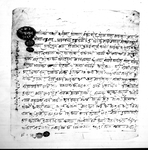A purjī from the Gorkhā Māla Aḍḍā ordering Subbā Dorje Indu Bhoṭe to have villagers fill out official forms (VS 1968)
ID: L_1200_0013
Edited and
translated by Rajendra Shakya
in collaboration with
Pabitra Bajracharya
Created: 2020-05-25;
Last modified: 2022-11-23
For the metadata of the document, click here
The accompanying edition, translation/synopsis and/or commentary are available under the terms of the Creative Commons Attribution-ShareAlike 4.0 International License
Abstract
This purjī from the Gorkhā Māla Aḍḍā instructs Subbā Dorje Indu Bhoṭe to get villagers to fill out a questionnaire seeking details of houses they have constructed on government land.Diplomatic edition
[1r]
1[Seal with the legend: श्रीगोर्खामाल१९६४]1[Seal with the legend: श्रीनरेन्द्रवहादुरराणा]1 [Unknown seal] 1सवालवमोजीउठाइकामतामेलगरीदीनेकामगरेवेसहोला1स्वस्तिश्रीपश्चीं२लंम्वरगोस्वाराजंङ्गीपरेट्गोर्षामाल्अदाकस्येअठारसै2षोला∙वहजाङ्गाऊवस्न्यासुव्वादोजेईन्दु∙भोटेकेपुर्जिउप्रान्तसेक्सेनफारं∙
3तय़ारगर्नालाईअठारसैषोलाकुठाङतरर्फकाभोटेगाऊको२|३पटक्फारं
4स्मेतदिपठायाको∙मा∙सोफारंवुझीनलीभागीकांअटकाउगरेको∙
5काले∙जाहेरगरेकामा∙भोटेहरुलेषननजान्याकोभयालेषनेमानीस्स्मेत्पठाई
6घरमाभय़ाको[?]गीगैह्रषोली∙ठान्यावमोजिंफारांतयारगरीलेषीतालुक
7दार∙जिम्माव़ाल्मुषीयाजोछ∙ऊसकोस्हीछापगराईल्याऊभंन्यासनदभैआ
8याकोहुनालेरतेसकुठाङगाऊकोकाठालुजानीफकारतीमीभय़ाकाले∙
9तीम्रानाऊमा∙पुर्जिलेषीपठायाकोछ∙तसअर्थपुर्जिदेषनेवित्तिकैतीमागा
10उकोर∙अरु∙गाऊगैह्रनेपालगोर्षासर्कारजगाकोघरकाप्रारगीकतिछं
11लगत्षडागर्नालाई∙भनीसंझाईवुझाईसोधीप्रारगीगैह्रषोलीठान्याव∙
12मोजींकोफारं∙तयारगराईतीमीलेरअरुगाऊगाऊका∙तालुकदारजिम्म
13वाल्थरीमुषीय़ाजोजोछंस्हीछापगराईसोफारंये़हीलेषनेहुदासीपाही
14हरु∙कासाथवुझाईदिन्याकामगरसोवमोजींनगरीपठाईनदीय़ानदीने
15मानीस्लाईपक्रील्याऊन्याछईतीसंम्वत्१९६८सालश्रावणगते२०रो
16ज१श्भ्म्1 [Seal with the legend: श्रीशिद्धीवाहादुरS.B.६७]1 [Unknown seal]
Translation
[Seal with the legend: ŚrīGorkhā Māla 1964]1
[Seal with the legend: Śrī Narendra Bahādura Rāṇā]2
[Unknown seal]
It would be good if the task, the task to be completed, is taken up and performed in accordance with the savāla.3
Hail! Written by the venerable Gorkhā Māla Aḍḍā [at] JaṅgīPareṭ4 [of] West No. 2 Gosvārā
A purjī to SubbāDorje Indu Bhoṭe, resident of Barjāṅ5 village in Aṭhāra Saya Kholā
Uprānta: A purjī has been issued in your name since you are a leading figure (ṭhālu) and a learned person (jāniphakāra) of the above Kutang village, a sanada having been issued with the following details:
"Forms have already been sent 2-3 times to the village of Bhoṭes6 [situated] in the Kutang7 side of the Aṭhāra Saya Kholā region to be prepared [as] section forms8 . [The villagers]9 reported, [however,] that [the intended recipient]10 impeded the work by running away instead of receiving those forms. [Therefore,] send [them], along with a scribe in cases where Bhoṭes do not know how to write, to be filled out and prepared in the proper format, so as to disclose the prāragīs11 and the like in [the villagers'] residences, and then have the tālukadāra, jimmāvāla, mukhiyā [or] whoever is present [there] sign [the forms] and [the latter] brought [here]."
Therefore, immediately after seeing this purjī, get the forms to be prepared in your village and other villages or the like into the proper format so as to disclose the prāragīs and the like. Having informed and convinced [the villagers] that [filling out the form with such details] is required for keeping records of how many prāragīs there are in houses [built] on the land of NepalGorkhaSarkāra, as [them for details]. [Then] get them (i.e. the forms) signed by you and the other tālukadāras, jimmāvālas, tharīs or mukhiyās present there, and complete the task of handing them over to the sipāhīs for recording here12 .
If the task is not carried out in accordance with the above [procedure] and [the forms] are not sent, then the person who does not send [the forms] shall be detained and brought [here].
Sunday, the 20th of Śrāvaṇa in the [Vikrama] era year 1968 (1911 CE). Auspiciousness.
[Seal with the legend: Śrī Śiddhī Bāhādura S.B. [19]67]13
[Unknown seal]
Commentary
At the beginning of this document, the names of two offices, West No. 2 Gosvārā and Gorkhā Māla Aḍḍā, are given as the issuing office but a seal with the lagend 'Śrī Gorṣā Māl 1964' confirms that it was sent by the latter, a revenue office. The year in the seal suggests that the revenue office was first established in Gorkha in VS 1964, four years prior to the date on this document. It appears that the office, which operated from or near an army parade ground, fell under the jurisdiction of the West No. 2 Gosvārā.
Gosvārā offices, which were led by a hākima, were first established by Raṇa Uddīpa Siṃha in the Terai districts as the head offices of district governments, and were charged with overseeing both executive and judicial matters (Kumar 1967: 109). The present document shows that a little over a couple of decades later, during the rule of Candra Śamśera, Gosvārā offices had already been established in the hill regions as well. This explains why the revenue office in Gorkha had apparently come under the jurisdiction of the Gosvārā office in the West No. 2 region. Although māla aḍḍā currently refers to an office that collects land revenue, māla aḍḍās in the Rāṇā administration generally collected other types of revenue as well.14 They received akabarī (excise duty on liquor), kascharai (tax on cattle grazed on pasture-land), and taxes from khair aḍḍās, which were established for the sale and export of catechu and timber washed away by floods (Regmi 1981: 152).
One confusing term, prāragī, hampers fully understanding the document. It appears that the land revenue office in Gorkha wanted to keep records of houses built on government land. Presumably the office did not yet have all the information on houses and land in the region and was in the process of compiling such records, as inferable from the fact that the office had presumably been established just four years earlier. Therefore, it sent a section form to the addressed village to be filled out by the villagers, calling for, among other things, disclosure of prāragī, which according to the content of the document is possibly something that is found in houses. An unnamed person who was supposed to receive the forms and get them filled out ran away before receiving them, whence purjī was sent to Subbā Dorje Indu Bhoṭe and tasked him with getting the job done.

